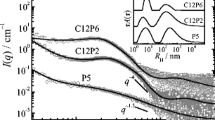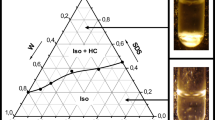Abstract.
Two distinct single-chain particles of poly(N-isopropylacrylamide) (PNIPAM) in the state of loose coil and compact globule, have been prepared successfully below and above the lower critical solution temperature (LCST) in extreme dilute aqueous solution by the freeze-drying method, respectively. During the preparation of the compact globular single-chain sample, the surfactant of sodium n-dodecyl sulfate (SDS) was added into the system to prevent aggregation of globular single chains formed at a temperature above the LCST. After all the coil has been transformed into the compact globular particle, the SDS molecules were removed by dialysis. The glass transition temperature (Tg) of the two single-chain samples has been measured by differential scanning calorimetery (DSC) in comparison with that of bulk polymer. It was found that the Tg of the single-chain sample in compact-globule state was very near to that of the bulk polymer, whereas the Tg of the single-chain sample in loose-coil state was approximately 6 K lower than that of the bulk polymer. After treating the sample with repeated DSC cycles, the Tg of the single-chain sample in loose-coil state rose up successively near to that of the bulk polymer. These results have been explained in terms of the effect of entanglement on the mobility of the polymer segments in the two distinct single-chain samples.
Similar content being viewed by others
References
R. Qian, in Comprehensive Polymer Science, 2nd Supplement, edited by G. Allen, S.L. Aggarwal, S. Russo (Elsevier Science Ltd., Oxford, 1996) pp. 541.
H. Bu, Y. Pang, D. Song, T. Yu, T. Voll, G. Czornyi, B. Wunderlich, J. Polym. Sci. B 29, 139 (1991).
H. Bu, S. Shi, E. Chen, H. Hu, J. Macromol. Sci. Phys. B 35, 731 (1996).
J. Cao, F. Gu, Y. Liu, S. Bi, H. Bu, Macromol. Symp. 124, 89 (1997).
R. Qian, L. Wu, D. Shen, D. Napper, R. Mann, D. Sangster, Macromolecules 26, 2950 (1993).
S. Wang, Dissertation, Nanjing University, China (1997).
S. Wang, Q. Dai, J. Hong, X. Yan, R. Cheng, Chem. J. Chin. Univ. 19, 1526 (1998).
M. Richardson, J. Polym. Sci. C 3, 21 (1963).
M. Furuta, J. Polym. Sci. Polym. Phys. Ed. 14, 479 (1976).
C. Ruscher, J. Polym. Sci. C 16, 2923 (1964).
G. Koszterszitz, W. Barnikol, G. Schulz, Makromol. Chem. 178, 1133 (1977).
R. Cheng, Macromol. Symp. 124, 27 (1997).
R. Qian, in Macromolecules, edited by H. Benoit, P. Rempp (Pergamon, Oxford, 1982) pp. 139.
R. Qian, T. Cao, S. Chen, F. Bai, Sci. China B 12, 1080 (1983).
J. Ding, G. Xue, Q. Dai, R. Cheng, Polymer 34, 3325 (1993).
D. Huang, Y. Yang, G. Zhuang, B. Li, Macromolecules 32, 6675 (1999).
D. Huang, Y. Yang, G. Zhuang, B. Li, Macromolecules 33, 461 (2000).
P. Bernazzani, S. Simon, D. Plazek, K. Ngai, Eur. Phys. J. E 8, 201 (2002).
Y. Mi, G. Xue, X. Lu, Macromolecules 36, 7560 (2003).
Y. Mi, J. Wang, Y. Zhang, E. Chen, S. Cheng, Polymer 42, 4533 (2001).
R. Qian, Macromol. Symp. 124, 15 (1997).
K. Kubota, S. Fujishige, I. Ando, J. Phys. Chem. 94, 5154 (1990).
H.G. Schild, Prog. Polym. Sci. 17, 163 (1992).
C. Wu, X. Wang, Y. Gao, Gaofenzi Xuebao 3, 9 (1998).
R. Walter, J. Ricka, Ch. Qullet, R. Nyffenegger, T. Binkert, Macromolecules 29, 4019 (1996).
H. Yang, X. Yan, R. Cheng, J. Polym. Sci. B 38, 1188 (2000).
H. Yang, R. Cheng, Z. Wang, Polymer, 44, 7175(2003).
H. Yang, X. Yan, R. Cheng, Macromol. Rapid Commun. 23, 1037 (2002).
O. Chiantore, M. Guaita, L. Trossarelli, Makromol. Chem. 180, 969 (1979)
Author information
Authors and Affiliations
Corresponding author
Rights and permissions
About this article
Cite this article
Yin, W., Yang, H. & Cheng, R. Glass transition of the two distinct single-chain particles of poly(N-isopropylacrylamide). Eur. Phys. J. E 17, 1–5 (2005). https://doi.org/10.1140/epje/i2004-10113-2
Received:
Accepted:
Published:
Issue Date:
DOI: https://doi.org/10.1140/epje/i2004-10113-2




